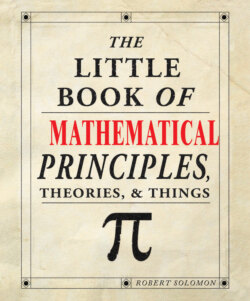Читать книгу The Little Book of Mathematical Principles, Theories & Things - Robert Solomon - Страница 34
2nd century BC China Negative Numbers
ОглавлениеThe extension to numbers less than zero.
_______________
Negative numbers make sense in some contexts, but not in others. Where they are relevant they save a lot of time but mathematicians did not accept them as proper numbers until comparatively recently.
It makes no sense to say “There are minus five people in the room.” However, in many other contexts it is useful to have numbers which are less than zero. One familiar example is temperature: at 0°C water freezes and we require numbers to describe temperatures lower than that figure. In commerce, too, it is useful to have negative numbers to describe a debt.
Chinese mathematicians were the first to accept negative numbers. They did their arithmetic on a chequerboard using short rods for the numbers. Red rods were used for positive numbers and black for negative, whereas the modern way of describing whether a bank-balance is positive or negative is the opposite way round.
Greek mathematicians did not recognize negative solutions of equations. In the 3rd century, Diophantus rejected x + 10 = 5, saying it was not a proper equation. Indian mathematicians came closer to accepting negative numbers, finding negative roots of quadratic equations. However, Bhaskara II (1114–1185) the leading mathematician in the 12th century, rejected these solutions, stating that people did not approve of them.
Nowadays, negative numbers are an essential part of mathematics. An example of their usefulness is in solving quadratic equations.
The equation ax2 + bx + c = 0 is solved by the formula:
Here a, b, and c can be positive or negative and the same formula fits all cases.
If we do not allow negative numbers, a, b, and c must be positive. There are several separate cases to consider:
ax2 + bx = c
ax2 + c = bx
ax2 = bx + c
Each of these separate cases will have a different formula. That makes three formulae to remember instead of just one!
The product of two negative numbers is positive. This fact is a part of school mathematics that is famously difficult to justify. Teachers have to rely on the following:
Minus times minus equals a plus.
The reason for this we shall not discuss.
See: Quadratic Equations, pages 11–12
